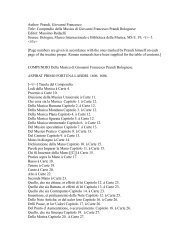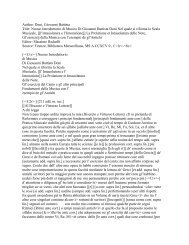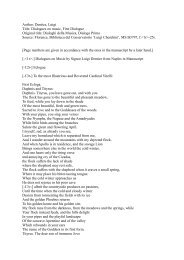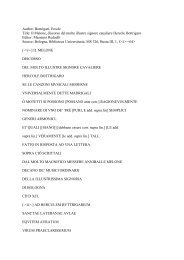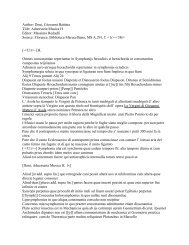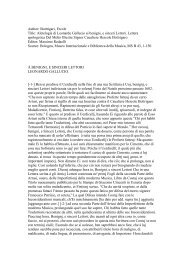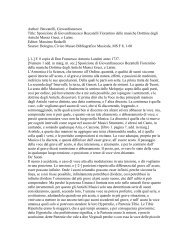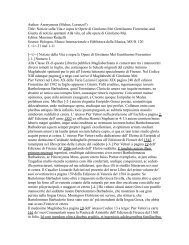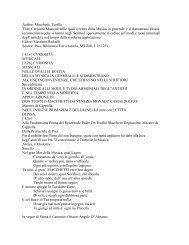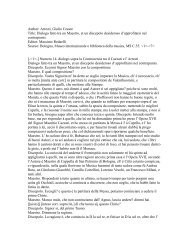Author: Doni, Giovanni Battista - manuscripts of italian music theory ...
Author: Doni, Giovanni Battista - manuscripts of italian music theory ...
Author: Doni, Giovanni Battista - manuscripts of italian music theory ...
You also want an ePaper? Increase the reach of your titles
YUMPU automatically turns print PDFs into web optimized ePapers that Google loves.
Some have believed, and among these Nicola Vicentino on the steps <strong>of</strong> Franchino<br />
Gaffurio, that the interval <strong>of</strong> the Semiditone belongs uniquely to the chromatic genus<br />
from the fact that it belongs to the definition <strong>of</strong> the chromatic, and, consequently, that<br />
it cannot be used in any way in the other kinds <strong>of</strong> melodies as the pure Diatonic or the<br />
pure Enharmonic ones. For the same reasons they believed that the Ditone is an<br />
interval which is typical and specific <strong>of</strong> the Enharmonic genus, so that it cannot and it<br />
must not be used in the other two genera, because were it to be used one would go<br />
beyond their natural disposition and they would be mixed together. These conclude<br />
that nowadays there are no Melodies which are purely Diatonic, because we see that<br />
these intervals are used in all <strong>of</strong> them without any restriction. This is so far removed<br />
from the truth and from every reason that anybody with a modicum <strong>of</strong> intellect can<br />
understand it easily. It is no wonder that Don Nicola, who laboured so much to restore<br />
the last two genera, and left also some compositions <strong>of</strong> his in print, wasted his effort<br />
and time, since his <strong>theory</strong> was not approved and that he was found to be mistaken by<br />
the judges who decided a certain dispute which he had with Lusitano, who was also a<br />
pr<strong>of</strong>essor <strong>of</strong> Music and maintained [-72-] against Vicentino that the melodies <strong>of</strong> our<br />
day are Diatonic and not mixed, as one can see in the treatise by Vicentino himself<br />
and in the Dialogue by Artusi on the imperfection <strong>of</strong> the <strong>music</strong> <strong>of</strong> our day. And that<br />
Don Nicola made a blunder, or ‘picked up a crab’, as they say, I will prove in a clear<br />
way. The Diatonic Genus came before the other tow and is common to all the nations<br />
who have no chromatic or Enharmonic genus. Even so, said intervals are found<br />
naturally in the Diatonic melodies and also in those which are composed naturally by<br />
shepherds. They would have been found certainly also in the most ancient songs<br />
which were popular before the invention <strong>of</strong> the other two genera. Therefore, they are<br />
not specific and limited to those two, but common to all. Nor it is appropriate to say<br />
that these intervals began to be excluded from the diatonic either by law or by habit<br />
after these two genera were introduced and the rules <strong>of</strong> each were established, firstly<br />
because it is fantasy without foundation and without the support <strong>of</strong> any author, nor<br />
one can believe that a custom so useless and a law so impertinent was ever accepted<br />
by the world, because this would be the same as if a poor <strong>music</strong>ian, having tuned his<br />
lyre diatonically, or with the natural intervals and notes <strong>of</strong> this genus which are heard<br />
in our small harp (as I have said above the System is nothing but a series <strong>of</strong> notes laid<br />
out one next to the other) was ordered by law [-73-] [I could also rely on Boethius’<br />
authority, who says at chapter 23 <strong>of</strong> the first book in marg.] never to play this or that<br />
note after having played another one, for instance, as if he were always forbidden to<br />
move by leap from E la mi to G sol re ut and from this one to [sqb] mi, from F fa ut to<br />
A la mi re, from Gsol re ut to [sqb] mi, from A la mi re to Csol fa ut, from [sqb] mi to<br />
D la sol re, from C sol fa ut to E la mi and from D la sol re to F fa ut. This would<br />
mean to tie his hands and to stop him to do what he pleases. Did they believe that this<br />
low had ever been accepted and the ancient had been so foolish and clumsy to observe<br />
it. Let it be established as certain and indubitable that in any disposition <strong>of</strong> notes in<br />
any genus it has always allowed and always will be [I will not pursue this matter<br />
further, because this opinion has been recited amply by Zarlino at chapter 75 <strong>of</strong> the<br />
third book <strong>of</strong> the third part <strong>of</strong> the Institutioni, and anyone will be able to consult it. I<br />
add only this, namely, that if the Tritonicon can be used in the Chromatic and<br />
Enharmonic genus, which is a very harsh interval, one and the other interval which<br />
are sweet and consonant are suited to each <strong>of</strong> those two genera in marg.] to use all the<br />
intervals that can be practised feasibly from a note to another and this wil not alter the<br />
nature <strong>of</strong> the genera. On the contrary the widening and shortening <strong>of</strong> the intervals,



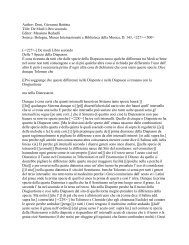
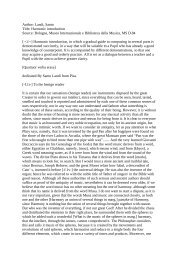
![Doni, Giovanni Battista Title: Trattato Dei Tuoni o [[Harmonie de]]](https://img.yumpu.com/45461005/1/190x245/doni-giovanni-battista-title-trattato-dei-tuoni-o-harmonie-de.jpg?quality=85)
